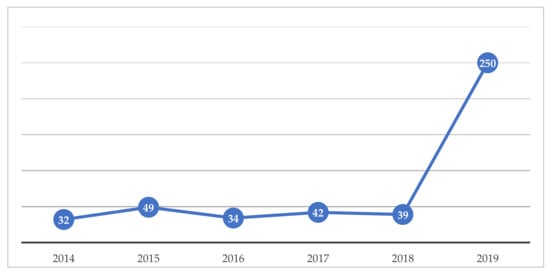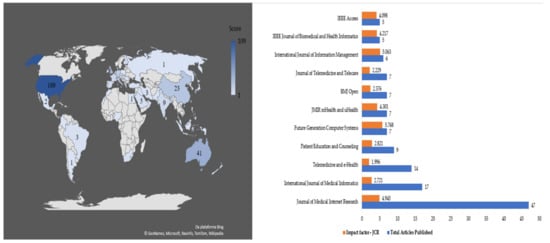You're using an outdated browser. Please upgrade to a modern browser for the best experience.
Please note this is an old version of this entry, which may differ significantly from the current revision.
Subjects:
Engineering, Civil
E-health can be defined as a set of technologies applied with the help of the internet, in which healthcare services are provided to improve quality of life and facilitate healthcare delivery.
- e-health
- ehealth
- practices
- technologies
1. Introduction
Digital change has been particularly challenging in healthcare, as there is growing demand for services due to the aging population and the emergence of new diseases. Thus, investment in new treatments is necessary so that everyone has equal access to the healthcare system [1][2][3]. E-health involves practices such as mhealth and telehealth that employ electronic technologies to provide healthcare resources, services, and information [4].
Mobile health or mhealth consists of the use of mobile devices so that patients can solicit services electronically, use apps to verify information, and manage or monitor treatment or problems or other health-related issues [5]. Telehealth can be defined as the use of telecommunication technologies to promote the care and education of patients and professionals working in the area [6].
E-health has become an integral part of the healthcare system as it addresses a range of difficulties in medicine, including reducing errors and providing more efficient services with more accurate results [7]. Such is the case with the use of electronic medical records, in which all information about a patient is stored, thus preventing inappropriate administration of medication during medical care and ensuring that the patient is treated quickly and comfortably [8]. However, its implementation depends on adequate planning and strategies so that virtual medical care can be performed [3].
The success of e-health in a country is related to several factors, including user acceptance and the types of infrastructure, systems, and management used [6][9]. Meanwhile, there are four stakeholders involved in the outcomes: entrepreneurs, healthcare professionals, patients, and those responsible for health insurance and assistance policies [10]. To effectively implement the use of information technologies in healthcare, e-health strategies must occur in an integrated manner, including the development of norms, laws, or regulations. This situation is valid whether in the fields of telehealth and mhealth, or specific categories such as electronic medical records or health literacy—eLearning (learning in health) [5][11][12].
The e-health strategy has three main components: (i) knowledge management; (ii) tools and methods; and (iii) policies. These components work to consolidate healthcare systems with support networks and scientific and technological production, manage infrastructure and human resources, reduce barriers to accessing health services, and promote community inclusion [13]. Some barriers to e-health include the difficulties faced when using systems and applications, both by healthcare professionals and patients, as well as ensuring the security and privacy of user data transmitted throughout these systems [12].
Another challenge in e-health is interoperability across systems. That is, new e-health systems must interact with existing ones, and there should be a standard electronic language between hospitals (or clinics) to facilitate communication and data exchange, as well as formal agreements on how the system should work in a standardized way [14][15]. Further, the cost of implementing e-health also presents challenges, which may make the implementation of such systems unfeasible. This is related to the high levels of investment required to purchase equipment to implement more sustainable practices [3][16] than traditional systems that store paper records, alongside the costs of hiring specialized support personnel in information technology (IT) to keep the systems running and software acquisition [8][17].
2. Bibliometric Analysis
Figure 2 shows the number of publications per year from 2014 to 2019.

Figure 1. Number of publications per year.
We can see that 2014 had the lowest number of publications on the topic and 2019 the highest. There was fluctuation in the number of publications, particularly between 2018 and 2019, when a marked increase in the number of studies related to the theme of e-health occurred. This increase is related to several factors. The area of mhealth has been growing, as has the number of chronic diseases and other health problems, while the advance of mobile technology has enabled greater access to e-health through devices, enabling an increase in research [18]. An increase in publication on the topic is also due to researcher interest, as it is current and still novel, allowing for greater numbers of studies on topics within the field, as is the case with reports published about e-health indicators, such as those from the Global Health Observatory of the World Health Organization (WHO) and the Nordic e-Health Research Network [19].
Although authors from 58 countries contributed to studies, the geographical distribution was uneven, as shown in Figure 2.

Figure 2. Distribution of articles by country and number of articles published by journal.
The leading countries in developing research related to e-health are United States (109), Australia (41), United Kingdom (32), China (23), Italy (19), Germany (18), Norway (14), and France (10). The countries with the fewest publication include Egypt (1), Mexico (2), and Brazil (3). In the study by [20] on e-health and health informatics skills, the authors found that the countries with the most authors who published on the topic were United States, Canada, United Kingdom, and Australia, and those with the least were Denmark and Norway.
Norway, Australia, Germany, the United Kingdom, United States, France, and Italy are countries with a remarkably high Human Development Index—HDI (which is based on the health, life expectancy, education, and income of a country’s population), while Egypt, Brazil, Mexico, and China are countries with high HDI. The wealthier a country is, the better its economic, political, and healthcare infrastructure, enabling more initiatives for e-health development, as has occurred in many European countries [21][22]. Each country has a different level of e-health development, and consequently, countries with more advanced e-health systems have a higher incidence of scientific production on the topic, such as European countries and the United States, as verified by [23]. Moreover, [24] state that although countries on the African continent and Latin America are publishing on the topic, the number of studies is still low as the countries have less developed e-health systems. Such is the case with Brazil and Mexico, which are still at the stage of telehealth improvement and consolidation.
The 446 articles in the portfolio were published across 253 academic journals. However, some journals among those identified stand out for having very few publications on the topic but a high impact factor, such as The Lancet (1 publication—60.392 JCR); British Medical Journal—BMJ (1 publication—30.223 JCR); IEEE Communications Surveys & Tutorials (1 publication—23.700 JCR); IEEE Internet of Things Journal (2 publications—9.936 JCR); Schizophrenia Bulletin (2 publications—7.958 JCR); Information Sciences (2 publications—5.910 JCR); AIDS and Behavior (3 publications—3.147 JCR); Social Science & Medicine (3 publications—3.616 JCR); International Journal of Environmental Research and Public Health (3 publications—2.849 JCR); Journal of the American Medical Informatics Association—JAMIA (4 publications—4.112 JCR); Frontiers in Psychiatry (4 publications—2.849 JCR); PLoS One (4 publications—2.740 JCR).
In the analysis by [25], who conducted a literature review on e-health, and [20], who did a bibliometric study, the journals that had the most publications were Journal of Medical Internet Research and Telemedicine and e-Health.
Therefore, for the research question “In which country and journals are studies on e-health practices published worldwide?” we can see that the United States stands out as it has the greatest number of authors who published on this topic, with 109 studies. Moreover, the Journal of Medical Internet Research is the most prominent scientific outlet for research on e-health, with 47 publications.
This entry is adapted from the peer-reviewed paper 10.3390/healthcare9091192
References
- Dhingra, D.; Dabas, A. Global strategy on digital health. Indian Pediatr. 2020, 27, 356–358.
- Negash, S.; Musa, P.; Vogel, D.; Sahay, S. Healthcare information technology for development: Improvements in people’s lives through innovations in the uses of technologies. Inf. Technol. Dev. 2018, 24, 189–197.
- Ross, J.; Stevenson, F.; Lau, R.; Murray, E. Factors that influence the implementation of e-health: A systematic review of systematic reviews (an update). Implementat. Sci. 2016, 11, 146.
- Mauco, K.L.; Scott, R.E.; Mars, M. Validation of an e-health readiness assessment framework for developing countries. BMC Health Serv. Res. 2020, 20, 575.
- Ćwiklicki, M.; Schiavone, F.; Klich, J.; Pilch, K. Antecedents of use of e-health services in Central Eastern Europe: A qualitative comparative analysis. BMC Health Serv. Res. 2020, 20, 171.
- Van Houwelingen, C.; Moerman, A.; Ettema, R.; Kort, H.; Cate, O.T. Competencies required for nursing telehealth activities: A Delphi-study. Nurse Educ. Today 2016, 39, 50–62.
- Jhamb, M.; Cavanaugh, K.L.; Bian, A.; Chen, G.; Ikizler, T.A.; Unruh, M.L.; Abdel-Kader, K. Disparities in electronic health record patient portal use in nephrology clinics. Clin. J. Am. Soc. Nephrol. 2015, 10, 2013–2022.
- De Grood, C.; Raissi, A.; Kwon, Y.; Santana, M. Adoption of e-health technolo-gy by physicians: A scoping review. J. Multidiscip. Healthc. 2016, 9, 335–344.
- Wolff-Piggott, B.; Coleman, J.; Rivett, U. The clinic-level perspective on mHealth implementation: A South African case study. Inf. Technol. Dev. 2018, 24, 532–553.
- Swinkels, I.C.S.; Huygens, M.W.J.; Schoenmakers, T.M.; Nijeweme-D’hollosy, W.O.; Velsen, L.V.; Vermeulen, J.; Schoone-Harmsen, M.; Jansen, Y.J.F.M.; Schayck, O.C.P.V.; Friele, R.; et al. Lessons learned from a living lab on the broad adoption of ehealth in primary health care. J. Med. Internet Res. 2018, 20, e9110.
- D’Agostino, M. Electronic health strategies in The Americas: Current situation and perspectives. Rev. Peru. Med. Exp. Salud Públ. 2015, 32, 352–355.
- Kho, J.; Gillespie, N.; Martin-Khan, M. A systematic scoping review of change management practices used for telemedicine service implementations. BMC Health Serv. Res. 2020, 20, 815.
- Pan American Health Organization—PAHO; World Health Organization—WHO. What Is eHealtH? Available online: https://www.paho.org/ict4health/index.php?option=com_docman&view=download&alias=18-fact-sheet-paho-ehealth-strategy-8&category_slug=materiales-comunicacion-8&Itemid=320&lang=en (accessed on 1 April 2020).
- Ali, R.; Qadri, Y.A.; Zikria, Y.B.; Umer, T.; Kim, B.-S.; Kimali, S.W. Q-learning-enabled channel access in next-generation dense wireless networks for IoT-based eHealth systems. EURASIP J. Wirel. Commun. Net. 2019, 178, 1–12.
- Costa, H.J.M.; Costa, C.A.; Righi, R.R.; Antunes, R.S. Fog computing in health: A systematic literature review. Health Technol. 2020, 10, 1025–1044.
- Schreiweis, B.; Pobiruchin, M.; Strotbaum, V.; Suleder, J.; Wiesner, M.; Bergh, B. Barriers and facilitators to the implementation of ehealth services: Systematic literature analysis. J. Med. Internet Res. 2019, 21, e14197.
- Hermes, S.; Riasanow, T.; Clemons, E.K.; Böhm, M.; Krcmar, H. The digital transformation of the healthcare industry: Exploring the rise of emerging platform ecosystems and their influence on the role of patients. Bus. Res. 2020, 13, 1033–1069.
- Mhealth—Market Estimates & Trend Analysis from 2016 to 2027. Available online: https://www.grandviewresearch.com/industry-analysis/mhealth-market (accessed on 19 September 2020).
- Haux, R.; Ammenwerth, E.; Koch, S.; Lehmann, C.U.; Park, H.-A.; Saranto, K.; Wong, C.P. A brief survey on six basic and reduced ehealth indicators in seven countries in 2017. Appl. Clin. Inform. 2018, 9, 704–713.
- Kokol, P.; Saranto, K.; Vošner, H.B. eHealth and health informatics competences: A systemic analysis of literature production based on bibliometrics. Kybernetes 2018, 47, 1018–1030.
- ITU—Telecommunication Development Sector. Implementing e-Health in Developing Countries. Available online: https://www.itu.int/ITU-D/cyb/app/docs/e-Health_prefinal_15092008.PDF (accessed on 20 September 2020).
- Programa das Nações Unidas para o Desenvolvimento—PNUD. O que é o IDH. Available online: https://www.br.undp.org/content/brazil/pt/home/idh0/conceitos/o-que-e-o-idh.html (accessed on 6 August 2021).
- Villumsen, S.; Adler-Milstein, J.; Nøhr, C. National monitoring and evaluation of eHealth: A scoping review. JAMIA Open 2020, 3, 132–140.
- Celes, R.S.; Rossi, T.R.A.; Barros, S.G.; Santos, C.M.L.; Cardoso, C. Telehealth as state response strategy: Systematic review. Rev. Panam. Salud Publ. 2018, 42, e84.
- Pagliari, C.; Sloan, D.; Gregor, P.; Sullivan, F.; Detmer, D.; Kahan, J.P.; Oortwijn, W.; MacGillivray, S. What Is eHealth (4): A scoping exercise to map the field. J. Med. Internet Res. 2005, 7, e391.
This entry is offline, you can click here to edit this entry!
